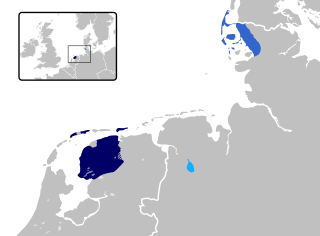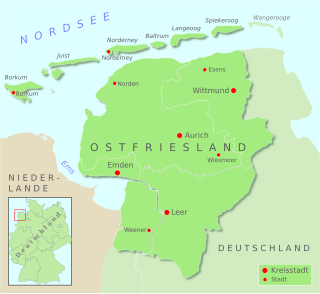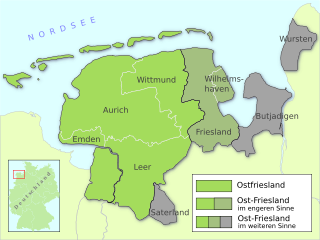
The Frisian languages are a closely related group of West Germanic languages, spoken by about 400,000 Frisian people, who live on the southern fringes of the North Sea in the Netherlands and Germany. The Frisian languages are the closest living language group to the Anglic languages; the two groups make up the Anglo-Frisian languages group and together with the Low German dialects these form the North Sea Germanic languages. However, modern English and Frisian are not mutually intelligible, nor are Frisian languages intelligible among themselves, owing to independent linguistic innovations and language contact with neighboring languages.

The Germanic languages are a branch of the Indo-European language family spoken natively by a population of about 515 million people mainly in Europe, North America, Oceania, and Southern Africa. The most widely spoken Germanic language, English, is also the world's most widely spoken language with an estimated 2 billion speakers. All Germanic languages are derived from Proto-Germanic, spoken in Iron Age Scandinavia, Iron Age Northern Germany and along the North Sea and Baltic coasts.

The East Frisian Islands are a chain of islands in the North Sea, off the coast of East Frisia in Lower Saxony, Germany. The islands extend for some 90 kilometres (56 mi) from west to east between the mouths of the Ems and Jade / Weser rivers and lie about 3.5 to 10 km offshore. Between the islands and the mainland are extensive mudflats, known locally as Watten, which form part of the Wadden Sea. In front of the islands are Germany's territorial waters, which occupy a much larger area than the islands themselves. The islands, the surrounding mudflats and the territorial waters form a close ecological relationship. The island group makes up about 5% of the Lower Saxony Wadden Sea National Park.

East Frisia or East Friesland is a historic region in modern Lower Saxony, Germany. The modern province is primarily located on the western half of the East Frisian peninsula, to the east of West Frisia and to the west of Landkreis Friesland but is known to have extended much further inland before modern representations of the territory. Administratively, East Frisia consists of the districts Aurich, Leer and Wittmund and the city of Emden. It has a population of approximately 469,000 people and an area of 3,142 square kilometres (1,213 sq mi).

The West Germanic languages constitute the largest of the three branches of the Germanic family of languages. The West Germanic branch is classically subdivided into three branches: Ingvaeonic, which includes English, the Low German languages, and the Frisian languages; Istvaeonic, which encompasses Dutch and its close relatives; and Irminonic, which includes German and its close relatives and variants.

West Frisian, or simply Frisian, is a West Germanic language spoken mostly in the province of Friesland in the north of the Netherlands, mostly by those of Frisian ancestry. It is the most widely spoken of the Frisian languages.

Saterland Frisian, also known as Sater Frisian, Saterfrisian or Saterlandic, spoken in the Saterland municipality of Lower Saxony in Germany, is the last living dialect of the East Frisian language. It is closely related to the other Frisian languages: North Frisian, spoken in Germany as well, and West Frisian, spoken in the Dutch province of Friesland.

North Frisian is a minority language of Germany, spoken by about 10,000 people in North Frisia. The language is part of the larger group of the West Germanic Frisian languages. The language comprises 10 dialects which are themselves divided into an insular and a mainland group.

East Frisian is one of the Frisian languages. Its last surviving dialect is Saterland Frisian spoken in Saterland in Germany.

The Heligoland Bight, also known as Helgoland Bight, is a bay which forms the southern part of the German Bight, itself a bay of the North Sea, located at the mouth of the Elbe river. The Heligoland Bight extends from the mouth of the Elbe to the islands of Heligoland and lies between the East Frisian island of Wangerooge and the North Frisian peninsula of Eiderstedt.

The Anglo-Frisian languages are the Anglic and Frisian varieties of the West Germanic languages.

Wangerooge is one of the 32 Frisian Islands in the North Sea located close to the coasts of the Netherlands, Germany and Denmark. It is also a municipality in the district of Friesland in Lower Saxony in Germany.

The Danish language has a number of regional and local dialect varieties. These can be divided into the traditional dialects, which differ from modern Standard Danish in both phonology and grammar, and the Danish accents, which are local varieties of the standard language distinguished mostly by pronunciation and local vocabulary colored by traditional dialects. Traditional dialects are now mostly extinct in Denmark, with only the oldest generations still speaking them.
Dutch dialects and varieties are primarily the dialects and varieties that are both cognate with the Dutch language and spoken in the same language area as the Standard Dutch. They are remarkably diverse and are found within Europe mainly in the Netherlands and northern Belgium.

East Frisians are, in the wider sense, the inhabitants of East Frisia in the northwest of the German state of Lower Saxony. In the narrower sense the East Frisians are the eastern branch of the Frisians, a distinct Germanic ethnic group, and are one of the nationally recognized ethnic minorities in Germany, along with the Danes, Sorbs, Sinti and Romanies. They are closely related to the Saterland Frisians, who come from East Frisia and moved from the coastal region to the interior. The East Frisians are also related to the North Frisians and the Westlauwers Frisians.

East Frisia is a collective term for all traditionally Frisian areas in Lower Saxony, Germany, which are primarily located on a peninsula between the Dollart and the Jade Bight. Along with West Frisia and North Frisia, it is one of the most commonly used subdivisions of Frisia.
Wursten Frisian was a dialect of the East Frisian language that is thought to have been spoken until the early 18th century in the landscape of Wursten between Bremerhaven and Cuxhaven, Germany. Together with Harlingerland Frisian and Wangerooge Frisian it belonged to the Weser Frisian group of dialects. The last East Frisian dialect still spoken today is Saterland Frisian, an Ems-group dialect.
Harlingerland Frisian is an extinct dialect of the East Frisian language. It was known for giving several features originally in Old Frisian. The language was only documented in the year 1691 with the book Memoriale linguae Frisicae, by Johann Cadovius-Müller. This dialect then slowly vanished and was displaced by the Harlings dialect of Low German. It belonged to the Weser dialects alongside the Wursten and Wangerooge Frisian dialects.












